A captivating group show at Charlie James Gallery looks at the (figurative) masks we wear
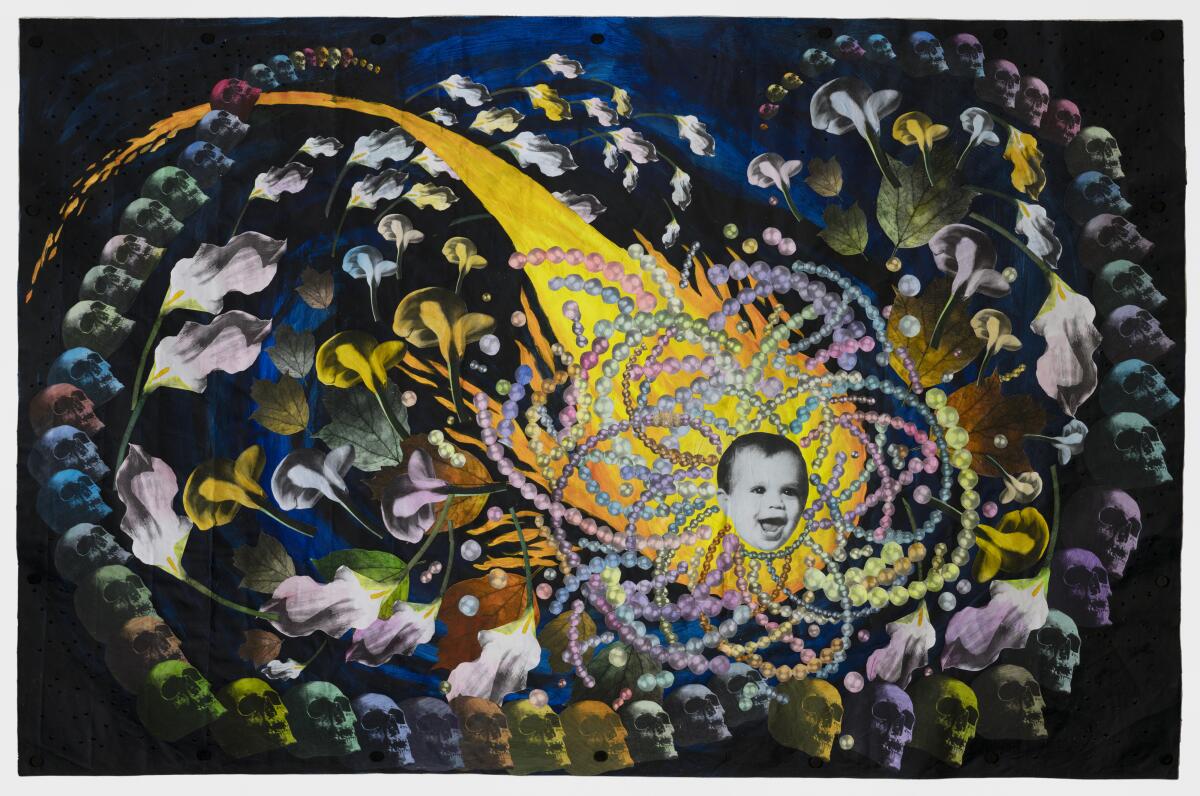
- Share via
I’m thinking about eating a hot dog from a hot dog because I’m into programmatic architecture and Tail o’ the Pup has made a comeback in WeHo (complete with a new menu that includes vegan dogs). I’m Carolina A. Miranda, arts and urban design columnist at the Los Angeles Times, and I’m always here for cylindrical foodstuffs — churros! taquitos! burritos! — as well as all the essential arts news:
Face it
What’s in a face? I’m talking about the word, which has many meanings that can be deployed in as many ways. It’s a noun: the front part of the head and its expressions, as well as a facade — such as the “face” of a building. It’s also a verb, referring to outward appearances one puts on to confront the world. We face facts, we lose face, we put a good face on a crummy situation.
The concept of face is at the heart of a captivating group show at Charlie James Gallery titled “Rostro” — the Spanish version of the word. Organized by Ever Velasquez, the show brings together an ambitious 40 artists from the U.S., Mexico and Puerto Rico who are exploring the myriad meanings of the concept in their work: literal faces, but also facades, and the figurative masks that we don in public that have nothing to do with COVID-19.
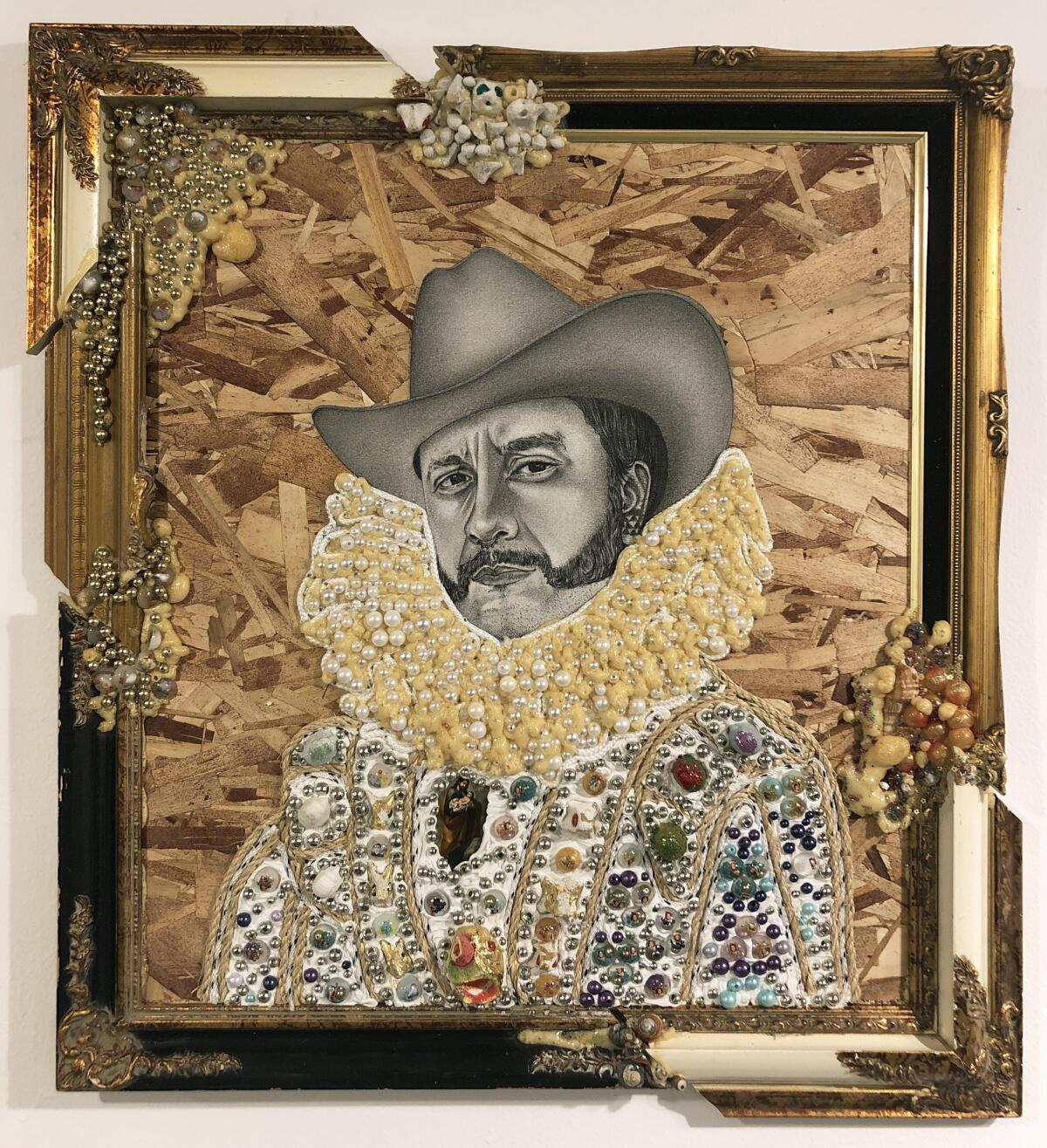
The show is a highly enjoyable rabbit hole — in terms of the meanings it explores but also the artists it presents (many of whom I had never laid eyes on before).
I was knocked out by a pair of paintings by Luis A. Sahagun, a Chicago artist who creates multimedia works that are greater than the sum of their parts: family portraits rendered in charcoal are collaged onto oriented strand board, a common construction material (and one embedded in many gallery walls), onto which he layers materials such as beads, shells and plastic gemstones to mimic the elaborate ruffed collars once worn by the sitters in 17th century Dutch paintings. The ways in which he employs materials and their meanings is wonderfully dexterous.
Make the most of L.A.
Get our guide to events and happenings in the SoCal arts scene. In your inbox every Monday and Friday morning.
You may occasionally receive promotional content from the Los Angeles Times.
Greeting visitors to the main gallery space is a nearly 7-foot-wide collage by Joey Terrill that features an image of the artist’s face as a baby emerging from a pattern that, from a distance, bears a vague resemblance to the helical patterns of DNA but, up close, reveals the image of the infant encircled by skulls. It is a painting that within an ebullience of pattern carries darkness. Terrill has lived with HIV for four decades. In this work, he faces life and death.
A pair of portraits by Shizu Saldamando capture the intimacy she feels with her subjects — frequently friends and fellow artists — rendering moments in which faces give away what might be going on within. Conversely, a painting by Danie Cansino shows a group of young women cruising, their faces defiant as they assertively stare down the viewer. It is the face as armor — a way of presenting ourselves to the world.
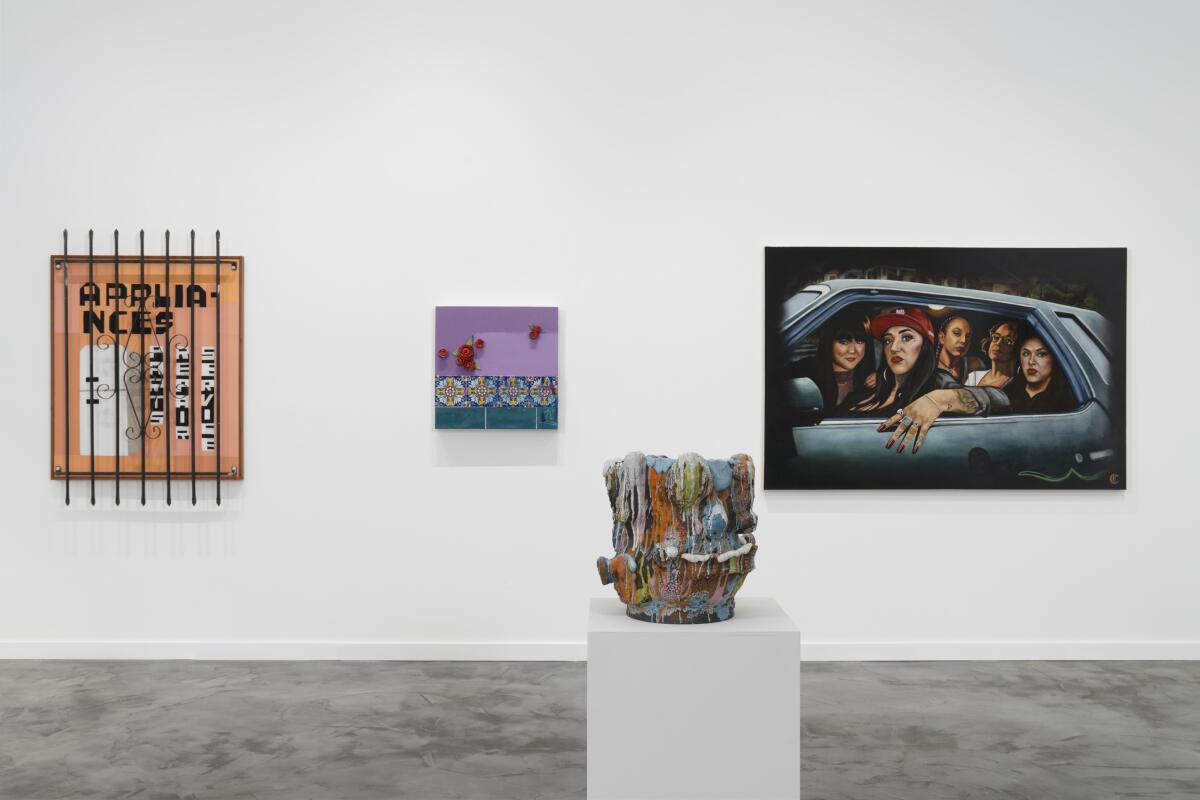
Other, more abstracted connotations of face also materialize — particularly within an architectural and urban context. Collaged works by Jeffrey Sincich repurpose the graphics and textures of urban spaces — signage, window bars — as a way of revealing how facades communicate to the passerby. In addition, a trio of charming paintings by Roberto Gutierrez capture scenes around the Eastside, its signs and symbols capturing the signifiers of L.A.’s Mexican faces.
I’m more of a June gloom kind of gal, but I dig summer shows because they generally tend to ignore the market in favor of the bizarre and the obscure. However, they are also very hit or miss. But “Rostro” explores new ground while remaining thoughtfully composed — with moments of poignance, ebullience, magic and grief.
A good reason to hang in L.A. when it’s hot.
“Rostro” is on view at Charlie James Gallery in Chinatown through Sept. 3.
Visual arts
“The Condition of Being Addressable,” currently on view at the ICA L.A. in downtown, brings together work by 25 artists examining marginal states. Organized by Marcelle Joseph and Legacy Russell, it couldn’t be more timely, writes Times art critic Christopher Knight, especially given the ripple effects of Roe vs. Wade on the bodies of everyone who gives birth. The show had some curious SoCal omissions, he notes. But he nevertheless encountered a range of striking work — such as an interactive piece by Sondra Perry that demands of the viewer answers for “what social conditions enabled you to even be in an art gallery, of all places, in the middle of the day.”

Since we’re on the subject of marginalized states: Photographer Samanta Helou Hernandez chronicled a street performance for KCET by artist Muxxxe, who with masked face and beaded gown honored the trans performers who frequently go unacknowledged by the entertainment industry.
Studio K.O.S., an art collective established by the late artist Tim Rollins in the ‘80s with Bronx schoolchildren, has landed at gallery O-Town House — the collective’s first L.A. show. The exhibition, titled “Invisible Man,” takes its name from Ralph Ellison’s novel, which also serves as literal source material for the show: Each work is crafted from pages in the book. “Are the books destroyed or reborn?” asks contributor Christina Catherine Martinez. “One definition of destroying a book would be to make it unreadable, yet the paintings are visceral evidence of a physical and energetic engagement with the text.”
Enjoying this newsletter? Consider subscribing to the Los Angeles Times
Your support helps us deliver the news that matters most. Become a subscriber.
Are you looking for a little art inspiration around Los Angeles? Christopher Knight just created an essential guide to the 17 works of art you need to see in L.A. County. Hint: It contains my favorite painting of a dog ever.
Classical notes
At the Hollywood Bowl, Yuval Sharon and the L.A. Phil staged a performance of Wagner’s “The Valkyries” that existed on two planes, one of which was occurring on the screen and the other on stage. Both planes held together, reports Times classical music critic Mark Swed. “For all the unreal landscape with eye-popping turquoise and purple mountains, red sky and unusual way the opera characters popped up — at one point a tiny Brünnhilde looked like Tinkerbell standing in Wotan’s gloved palm — this was absolutely traditional Wagner.”

The Paris Opera Ballet this week made its first appearance in Southern California since 2001. And it was a show that “overawed” the Hollywood Bowl, reports Swed. “No step by the mostly French dancers lacked elegance,” he writes. “No phrase of the exquisite 18th and 19th century, mostly French music was anything but elegant in the performances by the Los Angeles Philharmonic.”
Composer Basil Poledouris, who wrote scores for more than 50 feature films, including “The Blue Lagoon,” “Conan the Barbarian” and “RoboCop,” died young — at the age of 61 — in 2006. He is gone but not forgotten. On Friday, the Los Angeles Film Orchestra and Chorale played a tribute concert to this low-key composer who produced memorable music for cinema. “He honored the grandeur of Hollywood’s golden age, updated for the blockbuster era,” writes contributor Tim Greiving, “and his muscular themes and gentle folk melodies became permanently attached to several iconic characters.”
Greiving also reports on the Rise Diversity Project, an initiative organized by Musicians at Play that is aiming to diversify the ranks of orchestras working on Hollywood scores. “One of the problems is the pool of people who get called has not been diverse, and so it’s one of those chicken/egg things,” says French horn player Danielle Ondarza. “If you don’t have any experience, you’re really not appropriate for the job. But you can’t get experience unless you get called for the job.”
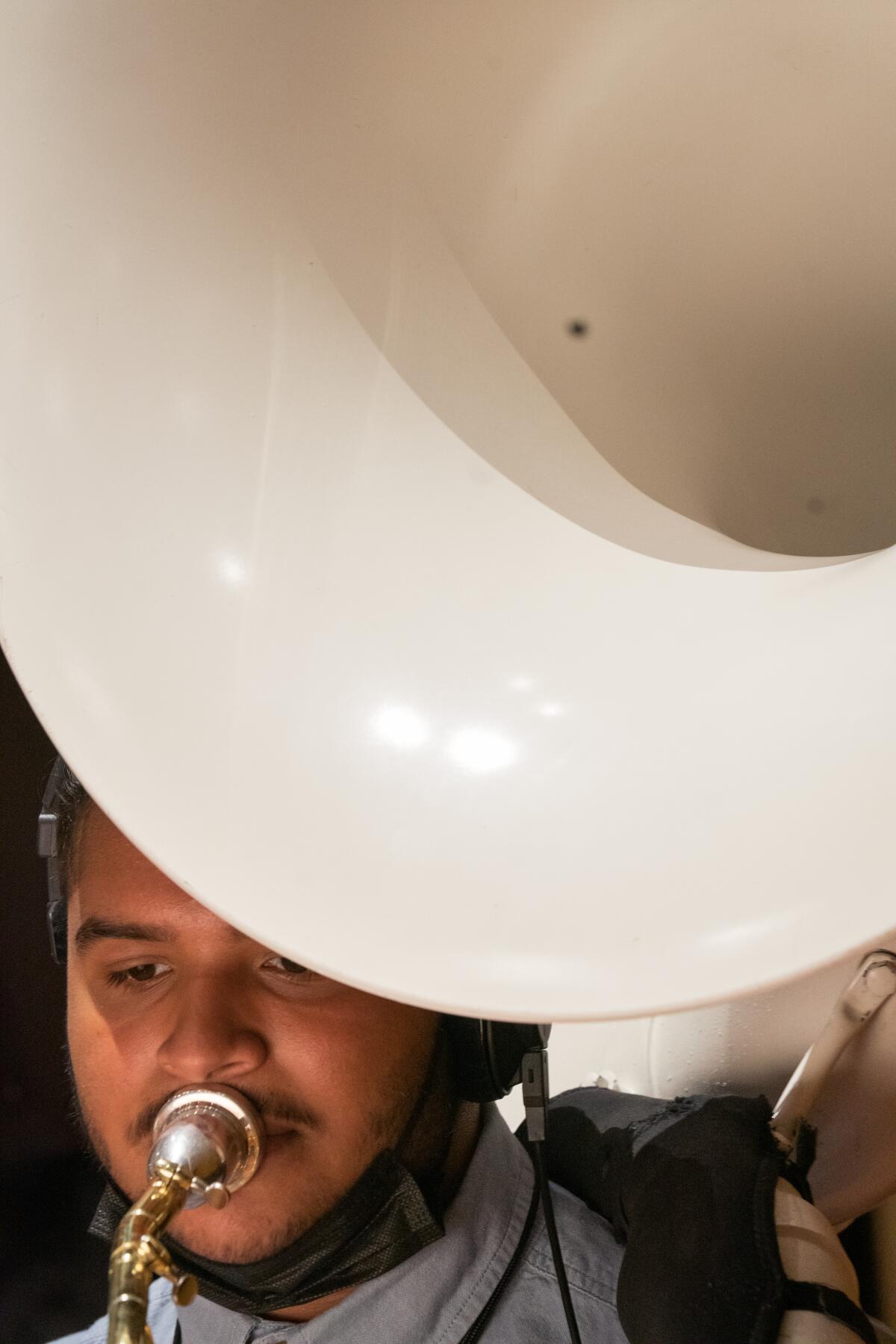
On and off the stage
The Times’ Daryl H. Miller chatted with Steven Levenson, who helped write the Broadway hit “Dear Evan Hansen” (now on view at the Ahmanson) and the screen adaptation of the musical “Tick, Tick ... Boom!” (which can be found on Netflix). His 2017 off-Broadway debut, “If I Forget,” is back on stage at the Fountain Theatre in Hollywood (directed by Jason Alexander). For Levenson, the play emerges from a personal space, tied to his upbringing and questions he had about Judaism, his family’s faith. “When I’m not quite sure how I feel about something,” he tells Miller, “I know that that means it’s ripe for exploration.”
Imagine an improvisational hip-hop show that every night features different guests and different improvised riffs drawn from audience prompts. That’s “Freestyle Love Supreme,” now playing at the Pasadena Playhouse. (It is also the subject of the Hulu doc “We Are Freestyle Love Supreme.”) Theater critic Charles McNulty was at opening night, where Wayne Brady appeared as a guest. The show featured “as much deadwood as virtuosity,” he writes. But the crew made for “affable company.”
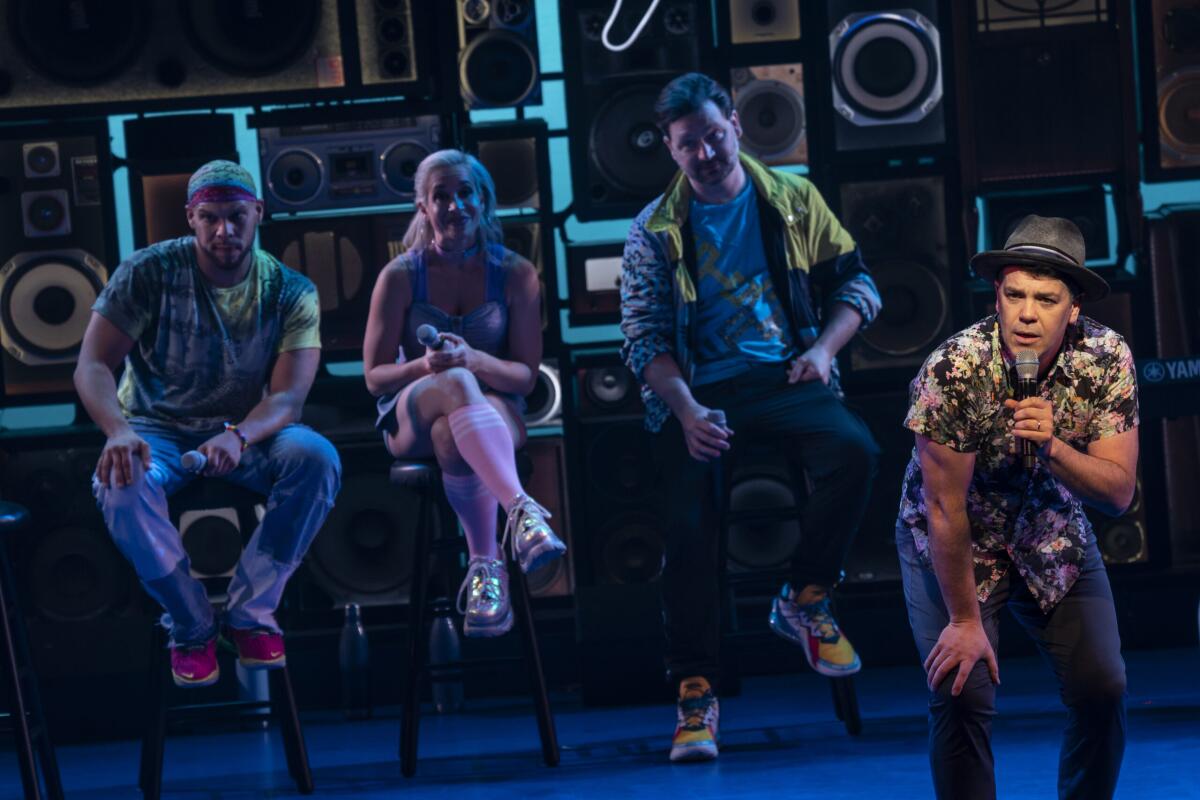
Essential happenings
Matt Cooper has the rundown for this week’s 7 best bets for L.A. culture, including a performance of “The Tempest” at Loyola Marymount, as part of the university’s Shakespeare on the Bluff festival, and a performance of groundbreaking composer Julius Eastman’s “Femenine” by the Wild Up orchestra at the Broad on Saturday evening. The Eastman show will be one not to miss!
Last week, I wandered into a small but intriguing show of ceramic works by Jazzy Romero at LaPau Gallery, which occupies a pair of closet-sized spaces in a rumpled building on the eastern edge of Koreatown. In one space, a film by the artist tells her mother’s story of migration from Michoacán; in the other, she presents a series of intriguing ceramic pieces that riff on Latin American visual tropes and the scrambled nature of migrant landscapes. “Servicios Express,” as the show is titled, is on view through July 30.
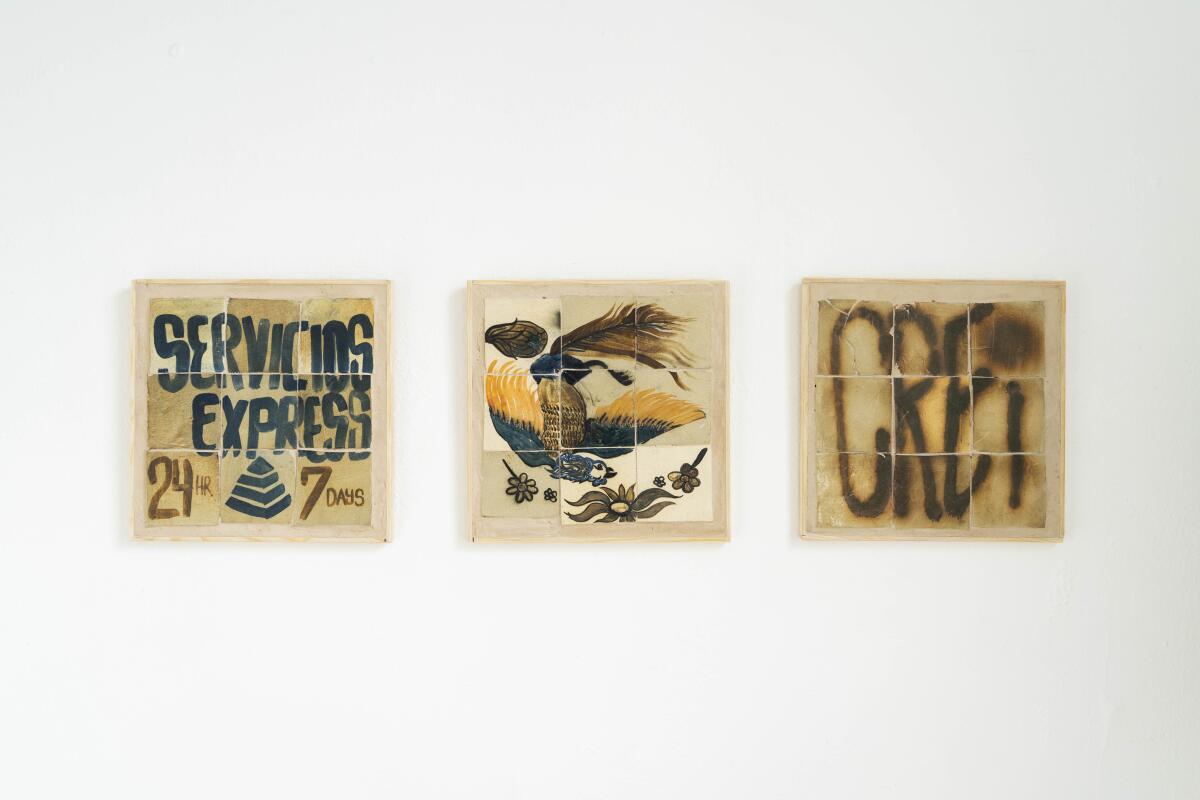
If you go, be sure to poke your head around the corner to Commonwealth and Council, where artist Beatriz Cortez is showing new steel sculptures that draw inspiration from the cosmic and portals between worlds. (In some ways, this too is a show about the ways in which matter is continuously moving through space.) “One eye yes, one eye no,” as the show is titled, is on view through Aug. 6.
Moves
Jawole Willa Jo Zollar, a choreographer who helped found the ensemble Urban Bush Women in 1984, has won the 29th annual Dorothy and Lillian Gish Prize.
The National Trust for Historic Preservation has awarded $3 million in grants to 33 sites to help preserve Black history. Among the chosen sites: architect Paul R. Williams’ Second Baptist Church of Los Angeles.
The Huntington Library has acquired the archives of architects John and Donald Parkinson.
L.A.’s Academy Museum will voluntarily recognize its new labor union, Academy Museum Workers United.
The Museum of Contemporary Art Santa Barbara will shut down on Aug. 18 after 47 years. The museum had been running deficits, and the pandemic was “the final nail in the coffin.”
Passages
Claes Oldenburg, the Swedish artist who took everyday objects, such as lipstick tubes, cherries and hamburgers, and made of them large-than-life representations — some stitched together out of soft textiles — has died at the age of 93. As former Times reporter Suzanne Muchnic writes in his obituary in The Times, “In his early days, he spoke of creating monuments that would have ‘an unbridled intense satanic vulgarity unsurpassable, and yet be art.’”
In an appreciation, Christopher Knight writes of Oldenburg’s legacy: “Popular culture is regularly misunderstood as the subject of Pop art, but Oldenburg knew that art culture is its actual focus. A core of his stellar achievement was his capacity to reveal art’s operations circulating within the spectral media-maze of contemporary society.”
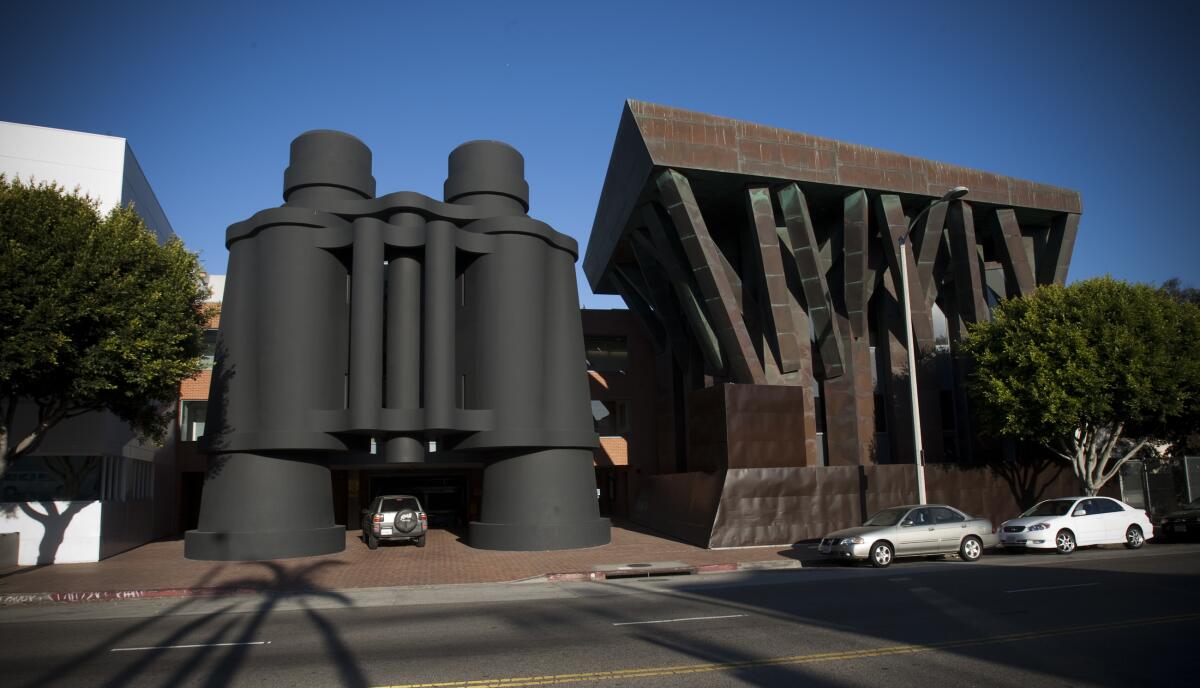
Lourdes Grobet, a multimedia artist and photographer who rose to fame in the ’80s with her images of Mexican luchadores engaged in the daily acts of quotidian life, has died 81.
I got to interview Grobet as part of an oral history I did with a group of Mexican feminist artists in advance of the Hammer Museum’s PST: LA/LA exhibition “Radical Women” in 2017. In that convo, she talked about turning to her native Mexico for inspiration: “This issue of the influence of European culture, I’ve always been wary of that. Mexican women are different, and especially Mexican rural women. So it’s another context. That’s why I’ve been dedicated to things like lucha libre instead of keeping my eye on what’s happening in Paris. All of my colleagues were always in Paris.”
In other news
— Get ready for Frida Kahlo, the musical.
— How L.A. artist Lisa Anne Auerbach reveals the ways in which our rights have been fraying before our eyes.
— Moorish-Tudor Fever Dream is my new band name.
— L.A. County-USC Medical Center has unveiled an artwork by Phung Huynh to honor the women who were forcibly sterilized at the hospital.
— The San Francisco Art Institute will shut down after USF announced it would back out of a deal to acquire the school.
— Preservationists have challenged a makeover plan for the Library of Congress’ main reading room.
— A little bit more than week into its existence, the 6th Street bridge was the site of a crash that plunged cars into bike lanes protected by nothing more than rubber slabs screwed into the pavement. This, writes Curbed’s Alissa Walker, raises a whole lot of questions about the ways in which the bike lanes were designed to begin with.
— It turns out that L.A. is building curb-protected bike lanes ... on 7th Street, Joe Linton reports.
— In Boston, Mayor Michelle Wu is championing free public transit for bus lines serving low-income communities.
— The heat wave is taking a toll on the Texas power grid, and as a result, it’s also battering crypto mining.
And last but not least ...
Missouri Sen. Josh Hawley running away from the Capitol rioters, set to a spectacular array of different soundtracks.
The biggest entertainment stories
Get our big stories about Hollywood, film, television, music, arts, culture and more right in your inbox as soon as they publish.
You may occasionally receive promotional content from the Los Angeles Times.




